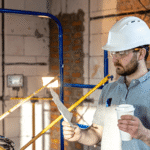The building envelope is more than just the outer shell of a structure—it is the critical barrier that protects the interior from air, water, and thermal infiltration. Ensuring that this system performs properly is essential for energy efficiency, occupant comfort, and long-term durability.
That is why building envelope testing has become a standard practice in modern construction, verifying that each element works together to maintain performance over time.
Understanding Building Envelope Testing
Building envelope testing evaluates how well a structure resists air leakage, water penetration, and heat transfer. These tests confirm whether materials and assemblies meet design specifications and perform as intended once installed.
By identifying potential weaknesses early, contractors can correct issues before they escalate into costly failures.
For both new construction and existing buildings, regular testing ensures that the envelope maintains its integrity throughout the structure’s lifecycle.
Key Types of Building Envelope Tests
1. Air Infiltration Testing
Air leakage increases heating and cooling loads, raises utility costs, and reduces indoor comfort. Air infiltration tests measure how much air passes through the envelope under pressure.
This process helps teams locate leaks and verify that the structure meets energy code requirements.
2. Water Penetration Testing
Water intrusion can cause structural damage, mold growth, and corrosion. Water penetration testing simulates rainfall and wind pressure to assess how the building’s façade, windows, and joints handle moisture exposure.
3. Thermal Imaging
Infrared thermography detects areas where heat escapes or moisture accumulates. It provides a visual map of thermal performance, allowing engineers to pinpoint insulation gaps or material defects.
4. Curtain Wall and Façade Testing
Complex façades require specialized testing to verify system integrity. Curtain wall tests evaluate pressure resistance, drainage performance, and sealant durability to ensure consistent protection against weathering.
5. Blower Door Testing
Blower door tests measure the airtightness of the entire building by depressurizing it with controlled airflow. The results reveal how effectively the envelope maintains energy efficiency.
Why Envelope Testing Matters for Long-Term Performance
A high-performing building envelope directly influences operating costs, sustainability, and occupant health.
Testing ensures that materials and installations work cohesively to prevent issues such as condensation, air drafts, or energy loss.
Over time, this translates into reduced maintenance costs and longer service life for the building’s structure and systems.
For developers and owners, envelope testing also provides documented proof of performance—an essential step toward achieving LEED, BREEAM, or Energy Star certifications.
Technology Advancements in Testing
Modern testing techniques have become more accurate through the use of digital sensors, automated monitoring, and real-time analytics.
Today’s tools allow engineers to record precise data on pressure differentials, temperature shifts, and moisture infiltration during testing.
Some advanced projects even integrate AI-based predictive analysis, allowing teams to anticipate future envelope performance based on current data trends.
The Path Toward Better Building Performance
Envelope testing is not a one-time process. As buildings age, environmental stress and material wear can reduce performance.
Routine testing and maintenance ensure that insulation, glazing, and sealing systems continue to perform as designed, extending the building’s operational life and improving indoor quality.
Image Credits: Freepik












